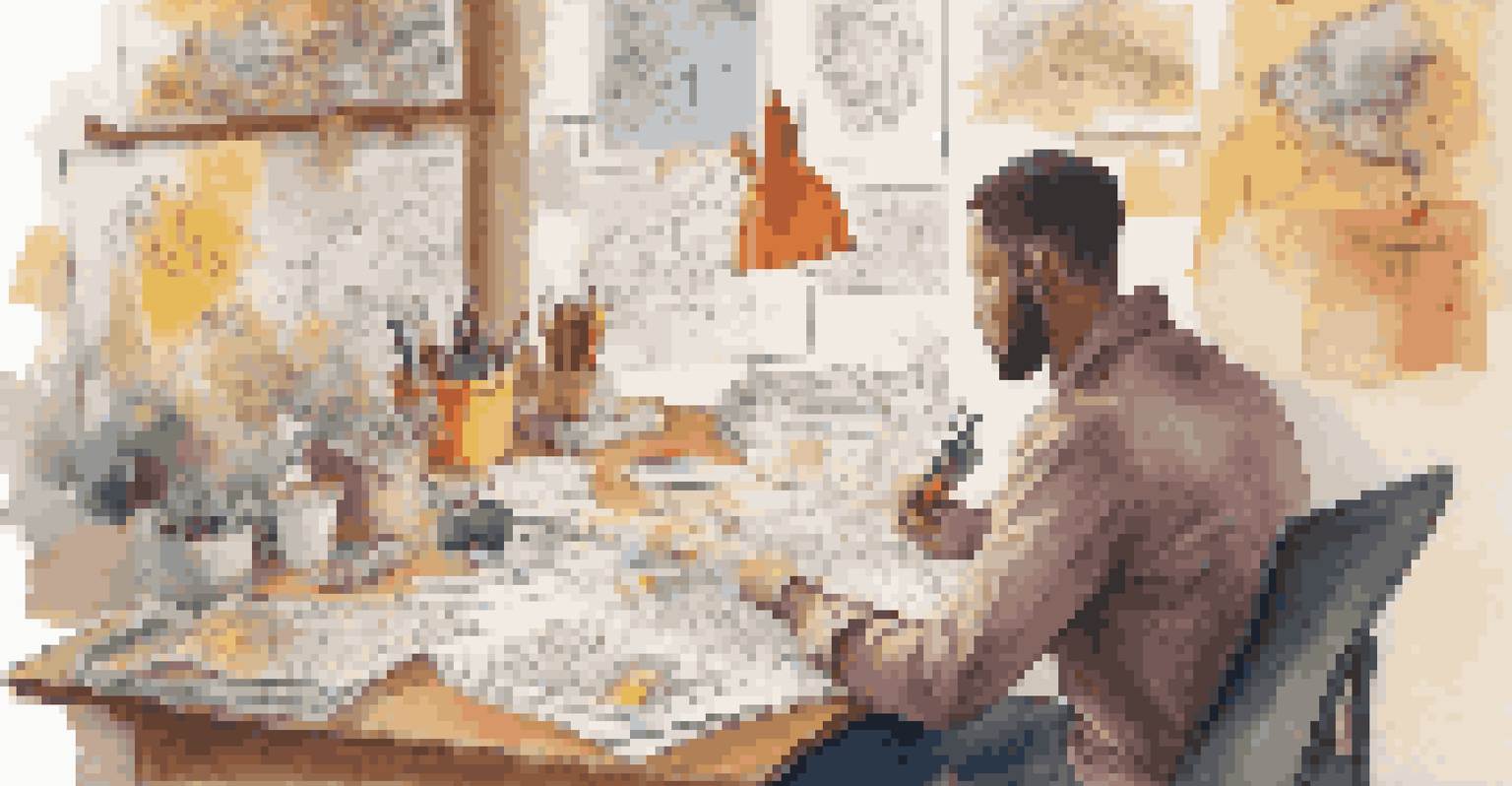Building a UX Portfolio: Tips for Aspiring Designers

Understand the Purpose of Your UX Portfolio
A UX portfolio is more than just a collection of your work; it’s a narrative of your design journey. It showcases your skills, thought processes, and the impact you've made through your designs. By understanding its purpose, you can create a portfolio that not only highlights your best projects but also communicates your unique approach to problem-solving.
Your portfolio is a reflection of your journey as a designer, showcasing not just what you've done, but how you think.
Think of your portfolio as a visual resume that tells a story about who you are as a designer. It should reflect your personality, design philosophy, and the value you bring to potential clients or employers. This storytelling aspect is crucial; it sets you apart from others who may have similar skills but lack a compelling narrative.
Ultimately, a well-crafted portfolio serves as a bridge between you and your audience, whether that's hiring managers, clients, or fellow designers. It’s your chance to make a lasting impression and to demonstrate how you can contribute to their goals.
Select Projects That Showcase Your Skills
Choosing the right projects for your portfolio is key to making an impact. Aim for a diverse selection that highlights various skills, such as user research, wireframing, prototyping, and usability testing. This breadth shows that you can tackle different challenges and adapt your approach based on project needs.

Instead of including every project you've ever worked on, focus on quality over quantity. Select projects that you are proud of and that reflect your best work, even if that means showcasing only a few. Highlighting your strongest pieces allows you to go deeper into your thought process and the design decisions you made.
Craft a Compelling UX Narrative
Your UX portfolio should tell a story that highlights your design journey, skills, and unique problem-solving approach.
Consider including a mix of personal projects, freelance work, and any collaborations. This variety can illustrate your versatility and passion for design, making your portfolio more relatable and engaging for viewers.
Include Case Studies to Tell Your Design Story
Case studies are a powerful way to show your design process and the impact of your work. They provide a structured way to explain your projects, detailing the problem, your approach, and the results achieved. This not only showcases your skills but also your ability to think critically and solve problems effectively.
Good design is about making other designers feel like idiots because that idea wasn’t theirs.
When crafting a case study, start with the challenge you faced and explain the research methods you used. Share insights from user interviews or usability tests that guided your design decisions. By doing this, you provide context that helps viewers understand the rationale behind your design choices.
Finally, don’t forget to include metrics or feedback that demonstrate the success of your design solutions. Whether it's increased user engagement or positive client feedback, tangible results can significantly strengthen your case studies.
Focus on Visual Design and Aesthetics
While content is essential, the visual appeal of your portfolio can't be overlooked. A clean, well-organized layout enhances the user experience of your portfolio itself and reflects your design sensibility. Use consistent typography, colors, and spacing to create a cohesive look that invites viewers to explore your work.
Think of your portfolio as a design project in itself. Just as you would prioritize user experience in your designs, ensure that your portfolio is easy to navigate and visually engaging. This attention to detail can make a significant difference in how your work is perceived.
Diverse Projects Reflect Skills
Selecting a variety of projects allows you to showcase your versatility and expertise across different aspects of UX design.
Remember, aesthetics play a crucial role in first impressions. A beautifully designed portfolio not only showcases your skills but also conveys professionalism and a commitment to quality.
Write Compelling Descriptions for Each Project
Descriptions are your opportunity to provide context and insights about your work. Avoid using overly technical jargon; instead, aim for clarity and relatability. Explain the problem you were solving, your design process, and the impact of your final solution in a way that resonates with your audience.
Tell a story with each description, making it engaging and informative. Use a conversational tone to invite readers into your design journey. This narrative approach can help potential employers or clients connect with your work on a deeper level.
Lastly, don’t forget to proofread your descriptions to ensure they are free of errors. Clear, concise writing reflects professionalism and attention to detail, which are vital traits in a successful designer.
Update Your Portfolio Regularly
A portfolio should be a living document that grows and evolves with your career. As you gain more experience and work on new projects, make it a habit to regularly update your portfolio. This not only keeps it fresh but also shows that you are actively engaged in your professional development.
Consider setting a schedule for updates, whether it’s quarterly or after completing significant projects. This way, you ensure that your portfolio accurately reflects your current skills and experiences. Removing outdated work can also help maintain the focus on your best and most relevant projects.
Regular Updates Enhance Relevance
Keeping your portfolio current with regular updates demonstrates your commitment to growth and ensures it reflects your best work.
Regular updates can also help you reflect on your growth as a designer. By revisiting past projects and seeing how your skills have developed, you can gain valuable insights that inform your future work.
Seek Feedback to Improve Your Portfolio
Feedback is an invaluable tool for refining your portfolio. Share your work with peers, mentors, or even online design communities to gather diverse perspectives. Constructive criticism can highlight areas of improvement you may not have considered, helping you create a stronger portfolio.
Be open to suggestions and use them to iterate on your design. Whether it's feedback on the layout, project selection, or descriptions, incorporating insights from others can elevate the quality of your work. Remember, every designer has different experiences and viewpoints that can enrich your portfolio.

Additionally, consider conducting user testing on your portfolio itself. Just as you would test a design, seeing how real users interact with your portfolio can provide critical insights into its usability and effectiveness.
Showcase Your Personality and Passion
Your portfolio is not just a display of your technical skills; it’s also a reflection of who you are as a designer. Don't shy away from showcasing your personality and passions through your work. This can be done through the projects you select, the language you use, and even the design of your portfolio.
Sharing personal projects or design explorations that excite you can help convey your enthusiasm for the field. Passion projects often resonate with viewers and can demonstrate your commitment to continuous learning and growth as a designer.
Ultimately, a portfolio that reflects your unique perspective can create a more memorable experience for viewers. This connection can set you apart in a competitive job market and attract opportunities that align with your values and goals.